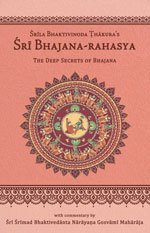Bhajana-Rahasya
by Srila Bhaktivinoda Thakura Mahasaya | 2010 | 123,965 words
The Bhajana-rahasya Text 11, English translation, including commentary (vritti). The Bhajana-rahasya is a compilation of verses describing the mercy of the eight pairs of names (Yugala-nama) of the Maha-mantra. This is text 11 belonging to the chapter “Shashtha-yama-sadhana (Sayam-kaliya-bhajana–bhava)” representing six dandas after dusk: approximately 6.00 p.m.–8.30 p.m.
Text 11
In Kṛṣṇa-karṇāmṛta (107), it is said that when attachment (rati) for the holy name arises, the youthful form of Kṛṣṇa easily manifests:
भक्तिस् त्वयि स्थिरतरा भगवन् यदि स्याद् दैवेन नः फलति दिव्य-किशोर-मूर्तिः
मुक्तिः स्वयं मुकुलिताञ्जलिः सेवते’स्मान् धर्मार्थ-काम-गतयः समय-प्रतीक्षाःbhaktis tvayi sthiratarā bhagavan yadi syād daivena naḥ phalati divya-kiśora-mūrtiḥ
muktiḥ svayaṃ mukulitāñjaliḥ sevate’smān dharmārtha-kāma-gatayaḥ samaya-pratīkṣāḥO Bhagavān, if someone has steady devotion unto Your lotus feet, he easily perceives Your most charming divine youthful form. Thereafter, liberation stands before him with folded hands, and dharma, artha and kāma also wait for an opportunity to serve him.
भक्ति स्थिरतरा याङ्र व्रजेन्द्र-नन्दन
तोमार कैशोर-मूर्ति ताङ्र प्राप्य धनbhakti sthiratarā yāṅra vrajendra-nandana
tomāra kaiśora-mūrti tāṅra prāpya dhanaकर-युडि’ मुक्ति सेवे ताङ्हार चरण
धर्म-अर्थ-काम करे आज्ञार पालनkara-yuḍi’ mukti seve tāṅhāra caraṇa
dharma-artha-kāma kare ājñāra pālana
Commentary: Bhajana-rahasya-vṛtti:
The pure name manifests in a person’s heart when he chants with pure devotees. At that stage, bhakti that is symptomised by prema manifests in his heart as visions of pastimes (līlā-sphūrtis). When this prema-bhakti becomes steadfast, Śrī Kṛṣṇa’s transcendental youthful form automatically appears in the heart. Although Mukti-devī is neglected by the devotee, she personally prays with folded hands for the devotee to accept her service. Dharma, artha and kāma also wait for the opportunity to beg the devotee for service.
The jāta-rati-bhakta inclined towards mādhurya-rasa is greatly allured by the divine adolescent form of Śrī Kṛṣṇa, whose topmost pastimes of amorous love (sṛṅgāra-rasa-vilāsa ) are displayed at this age.
Śrī Caitanya-caritāmṛta (Madhya-līlā 8.189) states:
रात्रि-दिन कुञ्जे क्रिडा करे राधा-सङ्गे
कैशोर-वयस सफल कैल क्रीडा-रङ्गेrātri-dina kuñje kriḍā kare rādhā-saṅge
kaiśora-vayasa saphala kaila krīḍā-raṅgeDay and night Śrī Kṛṣṇa enjoys the company of Śrī Rādhā in the kuñjas of Vṛndāvana. Thus, His adolescence is made successful through His pastimes with Her.
The amorous arts (rati-kalā), which employ a host of clever stratagems, manifest in their full sweetness during adolescence (kaiśora). Bhakti-rasāmṛta-sindhu states, “Śrī Kṛṣṇa embarrasses Śrī Rādhā by revealing to the sakhīs His skill and arrogance during the previous night’s amorous pastimes and showing them how He expertly painted wonderful keli-makarī [1] on Her breasts. In this way Śrī Kṛṣṇa sports in the kuñjas, making His youth successful.”
